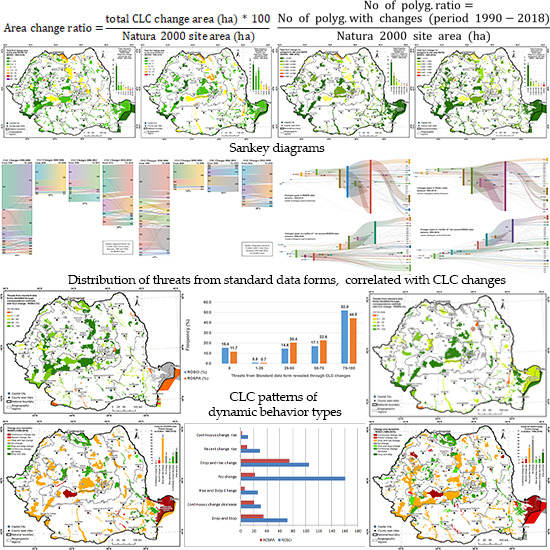Romanian Natura 2000 Network: Evaluation of the Threats and Pressures through the Corine Land Cover Dataset
Abstract
1. Introduction
2. Materials and Methods
2.1. Materials
2.2. Methodology
3. Results
3.1. Quantitative Analysis
3.1.1. Spatial Distribution of the Corine Land Cover Change within ROSPAs and ROSCIs
3.1.2. Total Surface Area Changes within Natura 2000 Sites
3.1.3. Number of Polygon Changes within Natura 2000 Sites
3.1.4. Temporal Perspective of the Corine Land Cover Change on ROSPAs and ROSCIs
3.1.5. Overall Dynamics of CLC Change within ROSPAs and ROSCIs
3.1.6. Diachronic Behavior Analysis of the CLC Change within ROSPAs and ROSCIs
- No change—there are no changes for the entire time period;
- Recent change rise—an increase in changes between 2012–2018;
- Drop and rise change—a decrease in changes until 2012, followed by an increase in change area until 2018;
- Continuous change decrease—a continuous decrease in changes for the entire 1990–2018 period;
- Rise and drop change—an increase in changes until 2012, followed by a decrease of changes, until 2018;
- Drop and stop—a total decrease in changes until 2006, and no further changes until 2018;
- Continuous change rise—there is a continuous increase in changes for the entire 1990–2018 period, despite all Natura 2000 implementations (Table 2 contains sample protected sites as examples that reflect types of dynamics concerning land cover).
3.1.7. Comparison between Land Cover Dynamics in the Former Protected Areas and in the New Ones
3.1.8. Comparing Dynamics from the Natura 2000 Sites with That from the Surrounding Buffer Zones
3.2. Qualitative Analysis
3.2.1. Correspondence between Corine Land Cover Changes and Natura 2000 Pressure and Threats
3.2.2. Types of Threats and Pressures Resulted from Correspondence in Romania
3.2.3. Confronting the Result with the Pressures and Threats Presented in the Standard Form Distributed on Each ROSPA and ROSCI
3.2.4. Irreversible Land Cover Changes—A Serious Threat to the Environment
4. Discussion
- by identifying key criteria for linking categories in different land cover classification systems and habitat classes, e.g., translation of CORINE Land Cover, the Food and Agricultural Organization (FAO) land cover classification system (LCCS) and the International Geosphere-Biosphere Program to Habitat Classification Systems (Natura 2000, Corine Biotopes, Eunis, General Habitat Categories) [42]. Certain habitat classes reflect a degree of anthropogenic impact and these would indicate a certain pressure, but closely related to biodiversity.
5. Conclusions
Author Contributions
Funding
Acknowledgments
Conflicts of Interest
References
- Yang, J.; Gong, P.; Fu, R.; Zhang, M.; Chen, J.; Liang, S.; Xu, B.; Shi, J.; Dickinson, R. The role of satellite remote sensing in climate change studies. Nat. Clim. Chang. 2013, 3, 875–883. [Google Scholar] [CrossRef]
- Dotzler, S.; Hill, J.; Buddenbaum, H.; Stoffels, J. The Potential of EnMAP and Sentinel-2 Data for Detecting Drought Stress Phenomena in Deciduous Forest Communities. Remote Sens. 2015, 7, 14227–14258. [Google Scholar] [CrossRef]
- Jitariu, V.; Vasiliniuc, I.; Rusu, C.; Roșca, B. The use of Sentinel 2 images for drought phenomenon monitoring in apple orchards. Int. Multidiscip. Sci. GeoConf. SGEM 2019, 19, 671. [Google Scholar] [CrossRef]
- Solberg, A.; Schistad, A.H. Remote Sensing of Ocean Oil-Spill Pollution. Proc. IEEE 2012, 100, 2931–2945. [Google Scholar] [CrossRef]
- Ning, S.-K.; Chang, N.-B.; Jeng, K.-Y.; Tseng, Y.-H. Soil erosion and non-point source pollution impacts assessment with the aid of multi-temporal remote sensing images. J. Environ. Manag. 2006, 79, 88–101. [Google Scholar] [CrossRef]
- Gallego Pinilla, F.J. Comparing CORINE Land Cover with a More Detailed Database in Arezzo (Italy) 2001. Available online: https://www.semanticscholar.org/paper/Comparing-CORINE-Land-Cover-with-a-more-detailed-in-Jrc/67037731cc23dfc3972984b969a9d45f794be282 (accessed on 15 October 2019).
- CORINE Land Cover — Copernicus Land Monitoring Service. Available online: https://land.copernicus.eu/pan-european/corine-land-cover (accessed on 4 October 2019).
- Napton, D.E.; Auch, R.F.; Headley, R.; Taylor, J.L. Land Changes and Their Driving Forces in the Southeastern United States. Reg. Environ. Chang. 2010, 10, 37–53. [Google Scholar] [CrossRef]
- Pelorosso, R.; Leone, A.; Boccia, L. Land cover and land use change in the Italian central Apennines: A comparison of assessment methods. Appl. Geogr. 2009, 29, 35–48. [Google Scholar] [CrossRef]
- Cieślak, I.; Szuniewicz, K.; Pawlewicz, K.; Czyża, S. Land Use Changes Monitoring with CORINE Land Cover Data. IOP Conf. Ser. Mater. Sci. Eng. 2017, 245, 052049. [Google Scholar] [CrossRef]
- Pekkarinen, A.; Reithmaier, L.; Strobl, P. Pan-European forest/non-forest mapping with Landsat ETM+ and CORINE Land Cover 2000 data. ISPRS J. Photogramm. Remote Sens. 2009, 64, 171–183. [Google Scholar] [CrossRef]
- Kucsicsa, G.; Popovici, E.-A.; Balteanu, D.; Grigorescu, I.; Dumitrascu, M.; Mitrica, B. Future land use/cover changes in Romania: Regional simulations based on CLUE-S model and CORINE land cover database. Landsc. Ecol. Eng. 2019, 15, 75–90. [Google Scholar] [CrossRef]
- Grigorescu, I.; Kucsicsa, G.; Popovici, E.-A.; Mitrica, B.; Mocanu, I.; Dumitrascu, M. Modelling land use/cover change to assess future urban sprawl in Romania. Geocarto Int. 2019. [Google Scholar] [CrossRef]
- Mücher, C.A.; Hennekens, S.M.; Bunce, R.G.H.; Schaminée, J.H.J.; Schaepman, M.E. Modelling the spatial distribution of Natura 2000 habitats across Europe. Landsc. Urban Plan. 2009, 92, 148–159. [Google Scholar] [CrossRef]
- Pullin, A.S.; Báldi, A.; Can, O.E.; Dieterich, M.; Kati, V.; Livoreil, B.; Lövei, G.; Mihók, B.; Nevin, O.; Selva, N.; et al. Conservation focus on Europe: Major conservation policy issues that need to be informed by conservation science. Conserv. Biol. 2009, 23, 818–824. [Google Scholar] [CrossRef] [PubMed]
- Primack, R.B.; Pătroescu, M.; Rozylowicz, L.; Iojă, C. Fundamentele Conservării Diversităţii Biologice; AGIR: Bucharest, Romania, 2008; ISBN 978-973-720-191-1. [Google Scholar]
- Baur, B.; Cremene, C.; Groza, G.; Rakosy, L.; Schileyko, A.A.; Baur, A.; Stoll, P.; Erhardt, A. Effects of abandonment of subalpine hay meadows on plant and invertebrate diversity in Transylvania, Romania. Biol. Conserv. 2006, 132, 261–273. [Google Scholar] [CrossRef]
- Ruprecht, E.; Enyedi, M.Z.; Eckstein, R.L.; Donath, T.W. Restorative removal of plant litter and vegetation 40 years after abandonment enhances re-emergence of steppe grassland vegetation. Biol. Conserv. 2010, 143, 449–456. [Google Scholar] [CrossRef]
- Stoate, C.; Báldi, A.; Beja, P.; Boatman, N.D.; Herzon, I.; van Doorn, A.; de Snoo, G.R.; Rakosy, L.; Ramwell, C. Ecological impacts of early 21st century agricultural change in Europe–A review. J. Environ. Manag. 2009, 91, 22–46. [Google Scholar] [CrossRef]
- Jones, W.; Silva, J.P. (Eds.) LIFE and Nature & Biodiversity Units of the Environment Directorate General (DG ENV) of the European Commission. 1 December 2008. Available online: https://ec.europa.eu/dgs/environment/index_en.htm (accessed on 21 October 2019).
- Thomson, A.G.; Manchester, S.J.; Swetnam, R.D.; Smith, G.M.; Wadsworth, R.A.; Petit, S.; Gerard, F.F. The use of digital aerial photography and CORINE-derived methodology for monitoring recent and historic changes in land cover near UK Natura 2000 sites for the BIOPRESS project. Int. J. Remote Sens. 2007, 28, 5397–5426. [Google Scholar] [CrossRef]
- Petrişor, A.-I. Assessment of the long-term effects of global changes within the Romanian Natural Protected Areas. Int. J. Conserv. Sci. 2016, 7, 759–770. [Google Scholar]
- Enea, A.; Hapciuc, O.-E.; Iosub, M.; Minea, I.; Romanescu, G. Water quality assessment in three mountainous watersheds from Eastern Romania (Suceava, Ozana and Tazlău rivers). Environ. Eng. Manag. J. 2017, 16, 605–614. [Google Scholar] [CrossRef]
- Enea, A.; Urzică, A.; Breabăn, I.G. Remote sensing, GIS and HEC-RAS techniques, applied for flood extent validation, based on LANDSAT imagery, LiDAR and hydrological data. Case study: Bașeu river, Romania. J. Environ. Prot. Ecol. 2018, 19, 1091–1101. [Google Scholar]
- CORINE Land Cover, Copernicus programme. Available online: https://land.copernicus.eu/pan-european/corine-land-cover (accessed on 2 October 2019).
- The Ministry of Environment, Water and Forests, Romania - GIS Data. Available online: http://www.mmediu.ro/articol/date-gis/434 (accessed on 5 October 2019).
- National Agency for Environmental Protection, Romania - Natura 2000 Standard forms. Available online: http://apmil.anpm.ro/informatii-natura-2000/-/asset_publisher/ikbc6radafTr/content/formulare-standard-natura-2000 (accessed on 4 October 2019).
- European Commission. The Habitats Directive-Environment- COUNCIL DIRECTIVE 92/43/EEC. Off. J. Eur. Communities 1992, 206, 7–50. [Google Scholar]
- Corine Land Cover 2006 Technical Report No. 17/2007. Available online: https://www.eea.europa.eu/publications/technical_report_2007_17 (accessed on 3 October 2019).
- Commission Implementing Decision of 11 July 2011. Available online: http://data.europa.eu/eli/dec_impl/2011/484/oj (accessed on 2 October 2019).
- Cole, B.; Smith, G.; Balzter, H. Acceleration and fragmentation of CORINE land cover changes in the United Kingdom from 2006-2012 detected by Copernicus IMAGE2012 satellite data. Int. J. Appl. Earth Obs. Geoinf. 2018, 73, 107–122. [Google Scholar] [CrossRef]
- Chávez, V.; Macdonald, S.E. Partitioning vascular understory diversity in mixedwood boreal forests: The importance of mixed canopies for diversity conservation. For. Ecol. Manag. 2012, 271, 19–26. [Google Scholar] [CrossRef]
- Brockerhoff, E.G.; Barbaro, L.; Castagneyrol, B.; Forrester, D.I.; Gardiner, B.; González-Olabarria, J.R.; Lyver, P.O.; Meurisse, N.; Oxbrough, A.; Taki, H.; et al. Forest biodiversity, ecosystem functioning and the provision of ecosystem services. Biodivers. Conserv. 2017, 26, 3005–3035. [Google Scholar] [CrossRef]
- Richards, A.E.; Forrester, D.I.; Bauhus, J.; Scherer-Lorenzen, M. The influence of mixed tree plantations on the nutrition of individual species: A review. Tree Physiol. 2010, 30, 1192–1208. [Google Scholar] [CrossRef] [PubMed]
- Petrisor, A.-I.; Petrisor, L.E. Transitional Dynamics Based Trend Analysis of Land Cover and Use Changes. Present Environ. Sustain. Dev. 2018, 12, 215–231. [Google Scholar] [CrossRef]
- The International Union for Conservation of Nature (IUCN). Available online: https://www.iucn.org/ (accessed on 2 October 2019).
- Mares, C.; Adler, M.-J.; Mares, I.; Chelcia, S.; Branescu, E. Climate Variability of the Hydro-Meteorological Extreme Events in Romania. 2013. Available online: https://ui.adsabs.harvard.edu/abs/2013EGUGA.15.9039M/abstract (accessed on 14 October 2019).
- Iojă, I.-C.; Hossu, C.-A.; Niţă, M.-R.; Onose, D.-A.; Badiu, D.-L.; Manolache, S. Indicators for Environmental Conflict Monitoring in Natura 2000 Sites. Procedia Environ. Sci. 2016, 32, 4–11. [Google Scholar] [CrossRef]
- Martínez-Fernández, J.; Ruiz-Benito, P.; Zavala, M.A. Recent land cover changes in Spain across biogeographical regions and protection levels: Implications for conservation policies. Land Use Policy 2015, 44, 62–75. [Google Scholar] [CrossRef]
- Gerard, F.; Petit, S.; Smith, G.; Thomson, A.; Brown, N.; Manchester, S.; Wadsworth, R.; Bugar, G.; Halada, L.; Bezák, P.; et al. Land cover change in Europe between 1950 and 2000 determined employing aerial photography. Prog. Phys. Geogr. 2010. [Google Scholar] [CrossRef]
- Rodriguez-Rodriguez, D.; Martinez-Vega, J.; Echavarria, P. A twenty year GIS-based assessment of environmental sustainability of land use changes in and around protected areas of a fast developing country: Spain. Int. J. Appl. Earth Obs. Geoinf. 2019, 74, 169–179. [Google Scholar] [CrossRef]
- Tomaselli, V.; Dimopoulos, P.; Marangi, C.; Kallimanis, A.S.; Adamo, M.; Tarantino, C.; Panitsa, M.; Terzi, M.; Veronico, G.; Lovergine, F.; et al. Translating land cover/land use classifications to habitat taxonomies for landscape monitoring: A Mediterranean assessment. Landsc. Ecol. 2013, 28, 905–930. [Google Scholar] [CrossRef]
- Piquer-Rodríguez, M.; Kuemmerle, T.; Alcaraz-Segura, D.; Zurita-Milla, R.; Cabello, J. Future land use effects on the connectivity of protected area networks in southeastern Spain. J. Nat. Conserv. 2012, 20, 326–336. [Google Scholar] [CrossRef]
- Santini, L.; Saura, S.; Rondinini, C. Connectivity of the global network of protected areas. Divers. Distrib. 2016, 22, 199–211. [Google Scholar] [CrossRef]
- de la Fuente, B.; Mateo-Sánchez, M.C.; Rodríguez, G.; Gastón, A.; Pérez de Ayala, R.; Colomina-Pérez, D.; Melero, M.; Saura, S. Natura 2000 sites, public forests and riparian corridors: The connectivity backbone of forest green infrastructure. Land Use Policy 2018, 75, 429–441. [Google Scholar] [CrossRef]
- Lawton, J.H.; Brotherton, P.N.M.; Brown, V.K.; Elphick, C.; Fitter, A.H.; Forshaw, J.; Haddow, R.W.; Hilborner, S.; Leafe, R.N.; Mace, G.M.; et al. Making Space for Nature: A Review of England’s Wildlife Sites and Ecological Network; Report to Defra; 2010; Available online: https://www.researchgate.net/publication/268279426_Making_Space_for_Nature_A_Review_of_England%27s_Wildlife_Sites_and_Ecological_Network (accessed on 21 October 2019).
- Lindborg, R.; Bengtsson, J.; Berg, Å.; Cousins, S.A.O.; Eriksson, O.; Gustafsson, T.; Hasund, K.P.; Lenoir, L.; Pihlgren, A.; Sjödin, E.; et al. A landscape perspective on conservation of semi-natural grasslands. Agric. Ecosyst. Environ. 2008, 125, 213–222. [Google Scholar] [CrossRef]
- Hooftman, D.A.P.; Bullock, J.M. Mapping to inform conservation: A case study of changes in semi-natural habitats and their connectivity over 70years. Biol. Conserv. 2012, 145, 30–38. [Google Scholar] [CrossRef]
- Kubacka, M.; Smaga, L. Effectiveness of Natura 2000 areas for environmental protection in 21 European countries. Reg. Envir. Chang. 2019, 19, 2079–2088. [Google Scholar] [CrossRef]
- Grădinaru, S.R.; Fan, P.; Iojă, C.I.; Niță, M.R.; Suditu, B.; Hersperger, A.M. Impact of national policies on patterns of built-up development: An assessment over three decades. Land Use Policy 2020, 94, 104510. [Google Scholar] [CrossRef]
- Lai, S.; Leone, F.; Zoppi, C. Anthropization Processes and Protection of the Environment: An Assessment of Land Cover Changes in Sardinia, Italy. Sustainability 2017, 9, 2174. [Google Scholar] [CrossRef]
- Fernandez-Nogueira, D.; Corbelle-Rico, E. Land Use Changes in Iberian Peninsula 1990-2012. Land 2018, 7, 99. [Google Scholar] [CrossRef]
- Abrantes, P.; Fontes, I.; Gomes, E.; Rocha, J. Compliance of land cover changes with municipal land use planning: Evidence from the Lisbon metropolitan region (1990–2007). Land Use Policy 2016, 51, 120–134. [Google Scholar] [CrossRef]
- Serra, P.; Vera, A.; Tulla, A.F.; Salvati, L. Beyond urban–rural dichotomy: Exploring socioeconomic and land-use processes of change in Spain (1991–2011). Appl. Geogr. 2014, 55, 71–81. [Google Scholar] [CrossRef]
- Sanderson, E.W.; Jaiteh, M.; Levy, M.A.; Redford, K.H.; Wannebo, A.V.; Woolmer, G. The Human Footprint and the Last of the Wild. bisi 2002, 52, 891–904. [Google Scholar] [CrossRef]
- Ursu, A.; Jitariu, V.; Ciutea, A. Estimating the Impact of Human Activities on the Environment in Moldova Region (HI Index). Present Environ. Sustain. Dev. 2017, 11, 129–140. [Google Scholar] [CrossRef][Green Version]
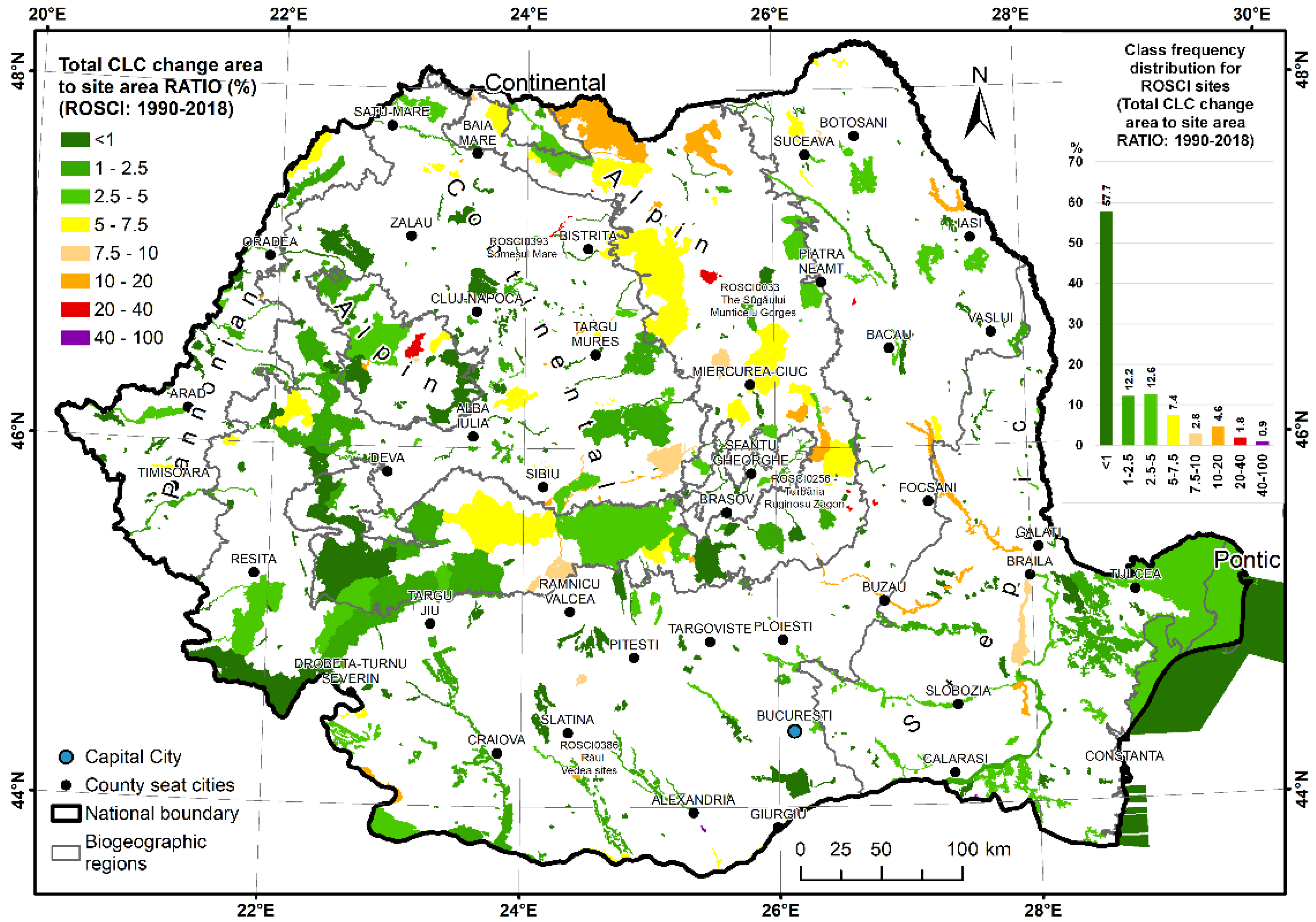
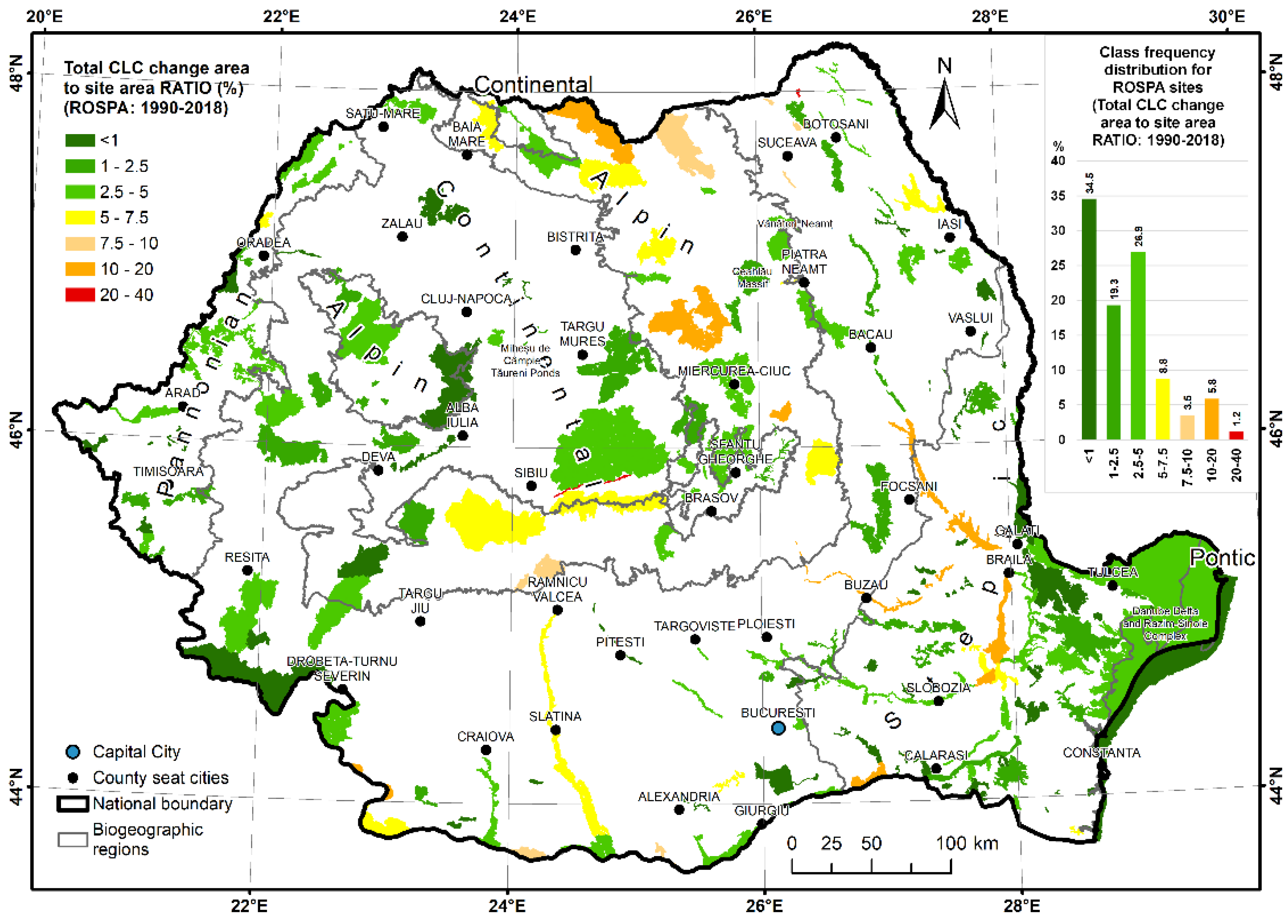
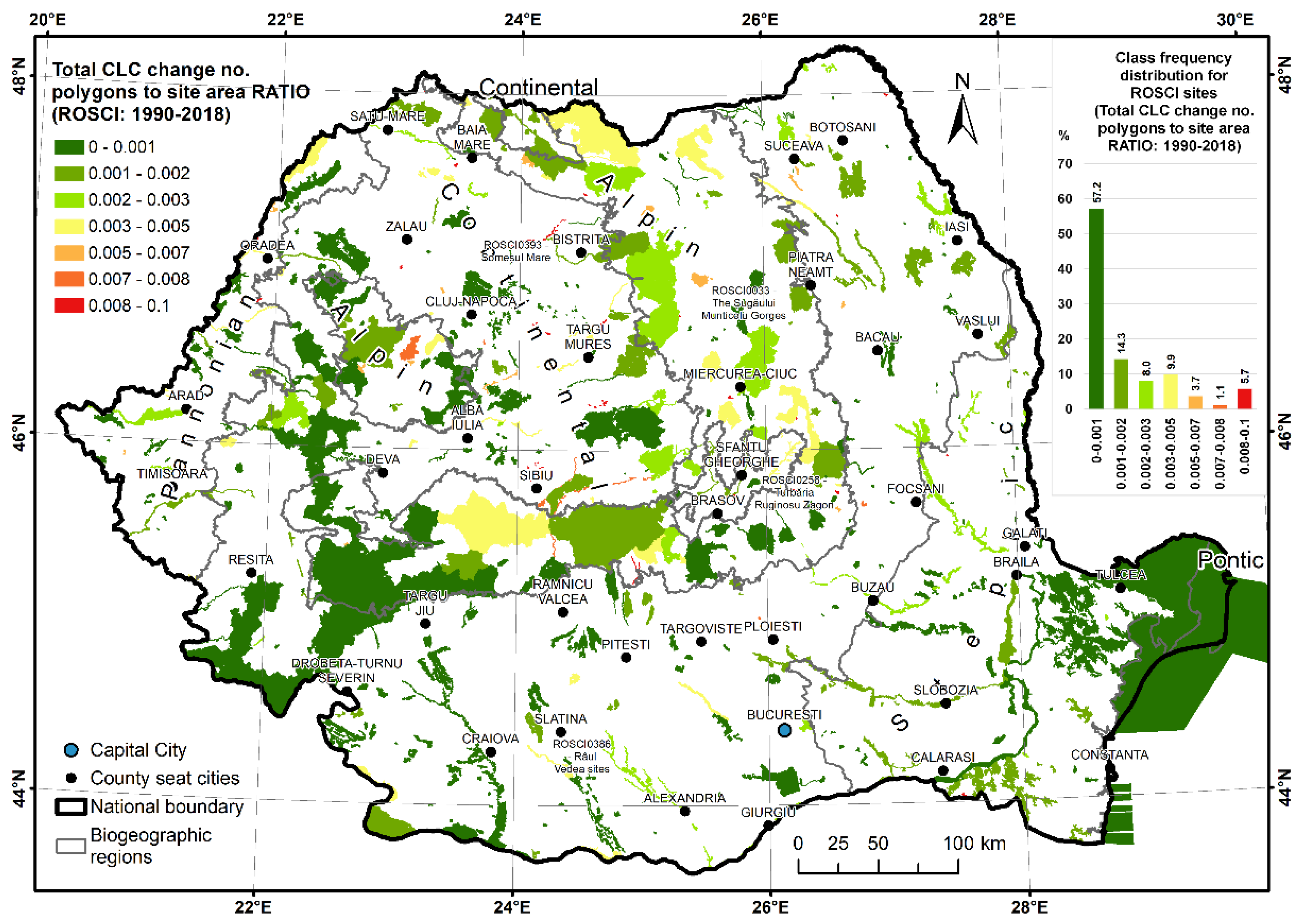
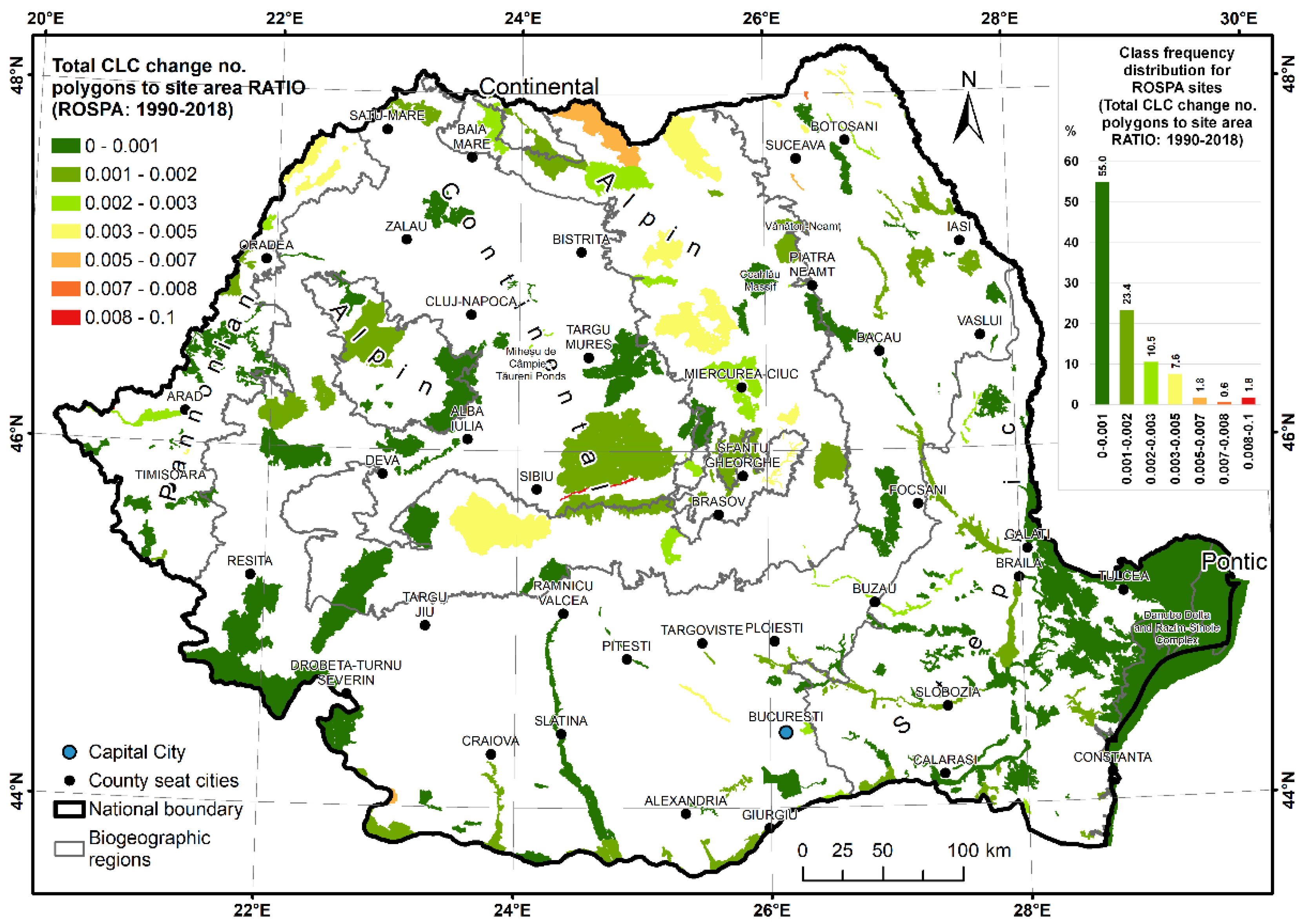
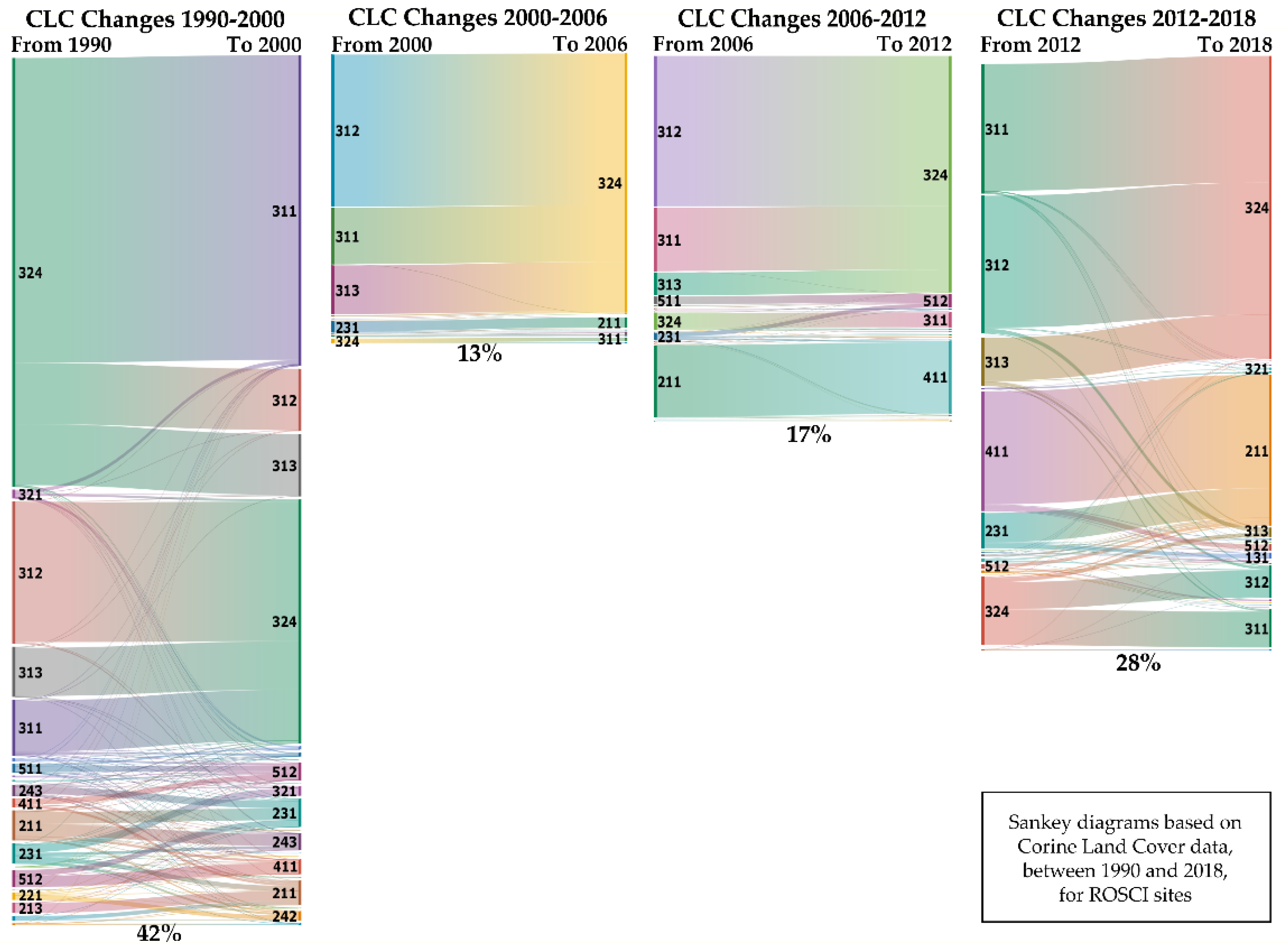


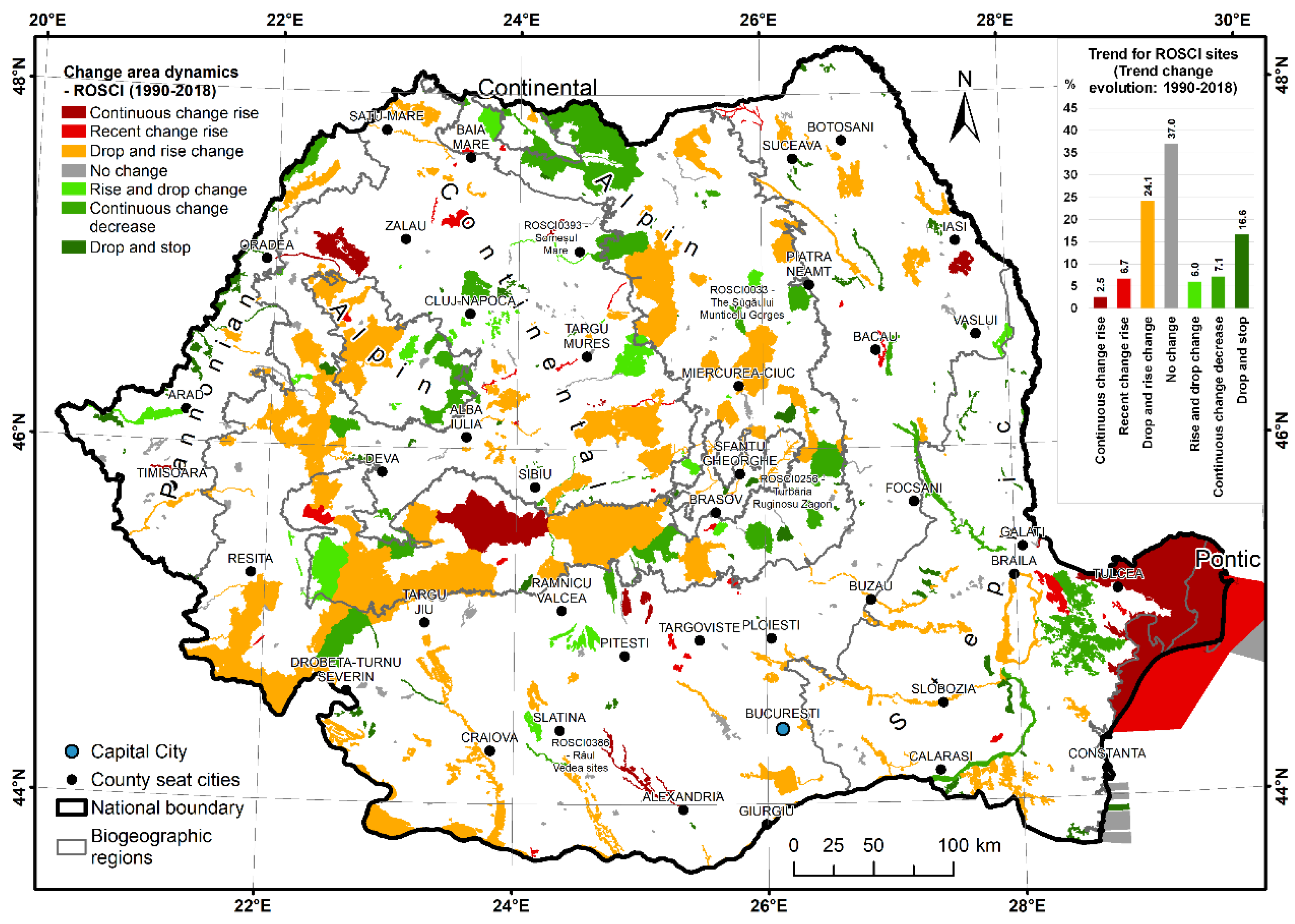



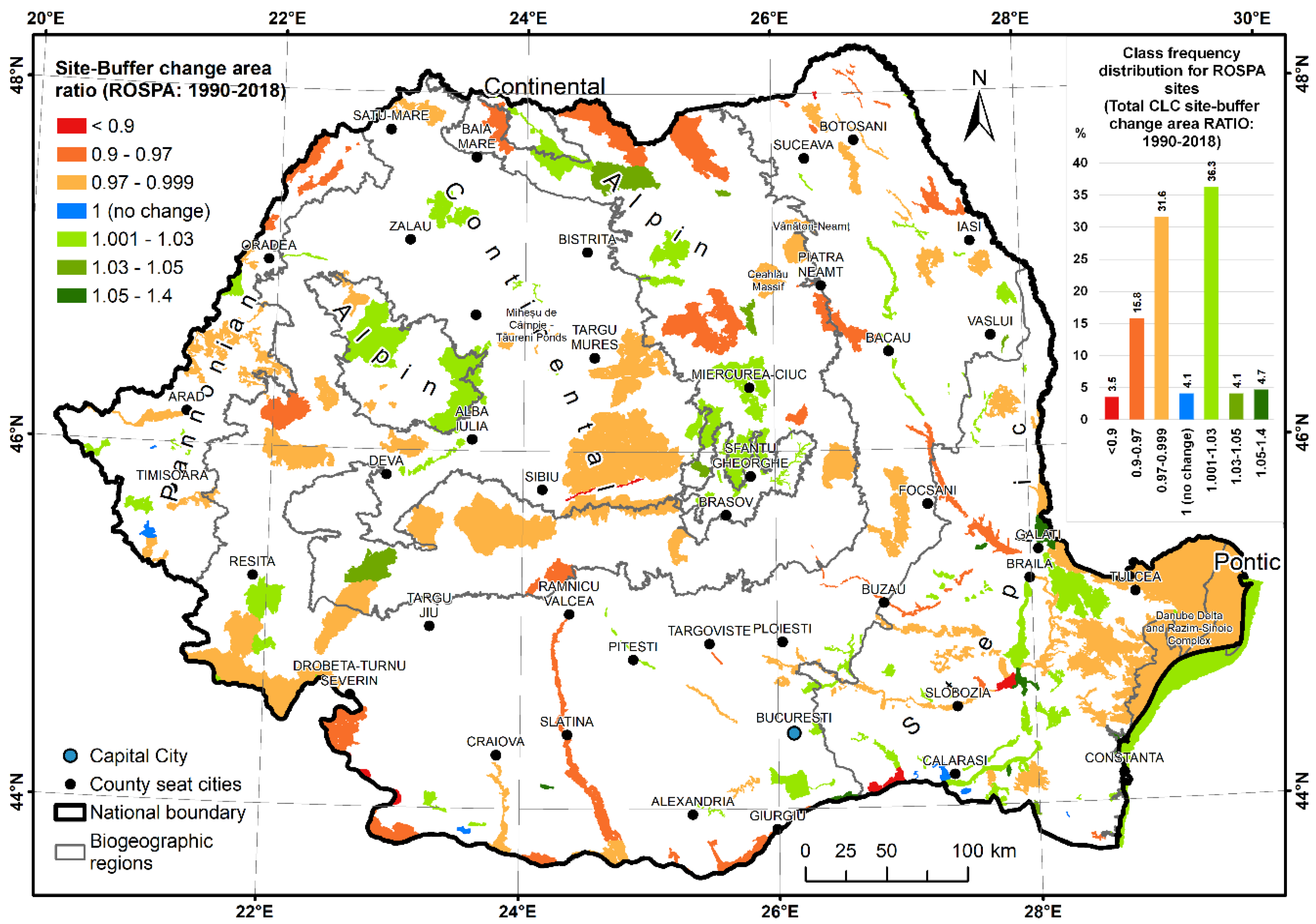


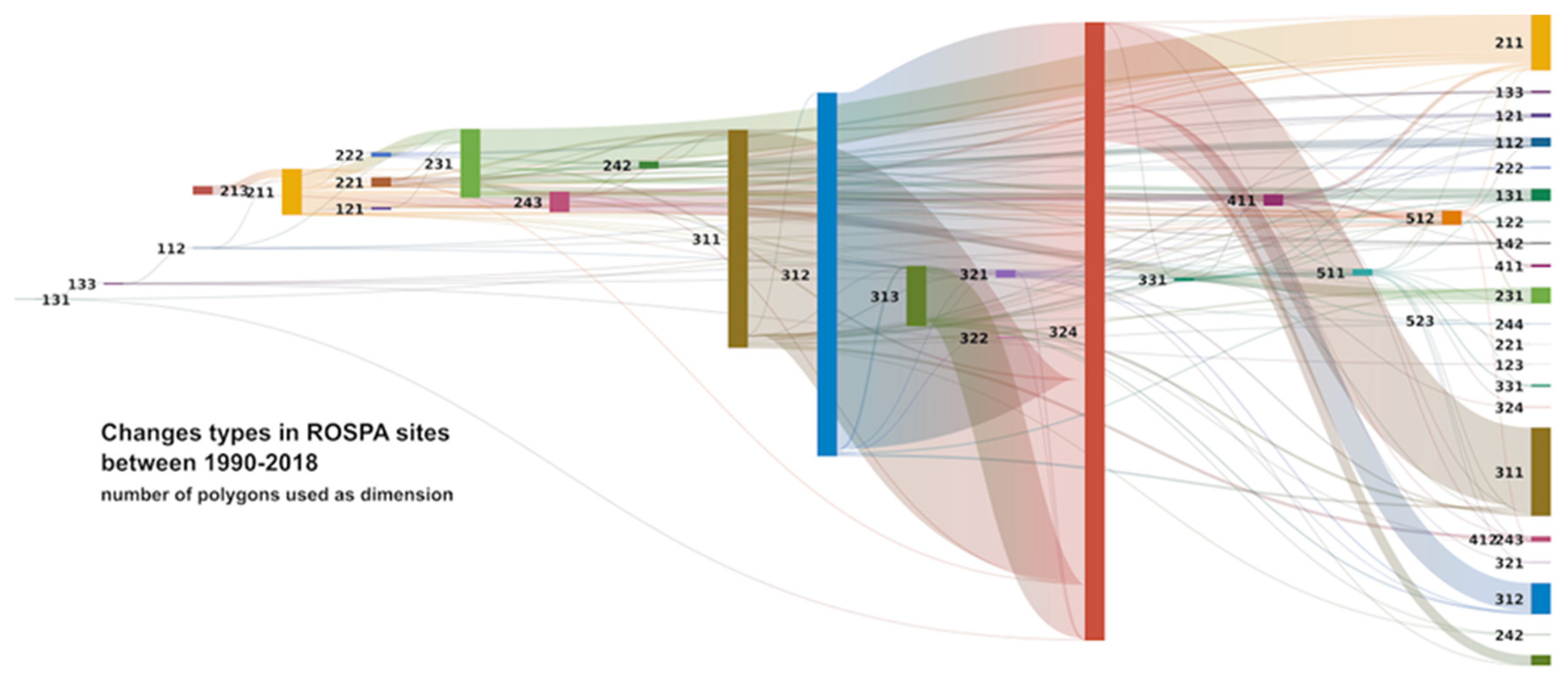
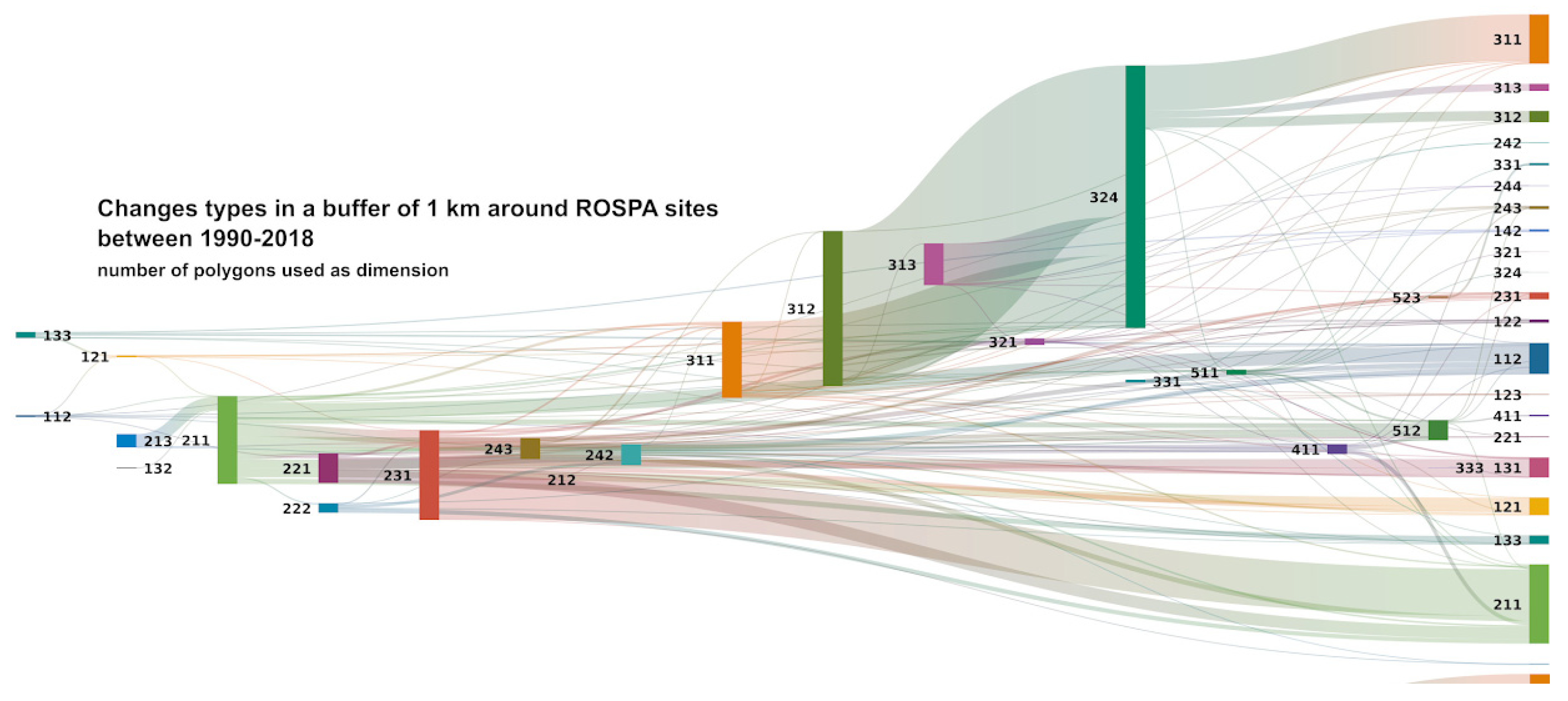



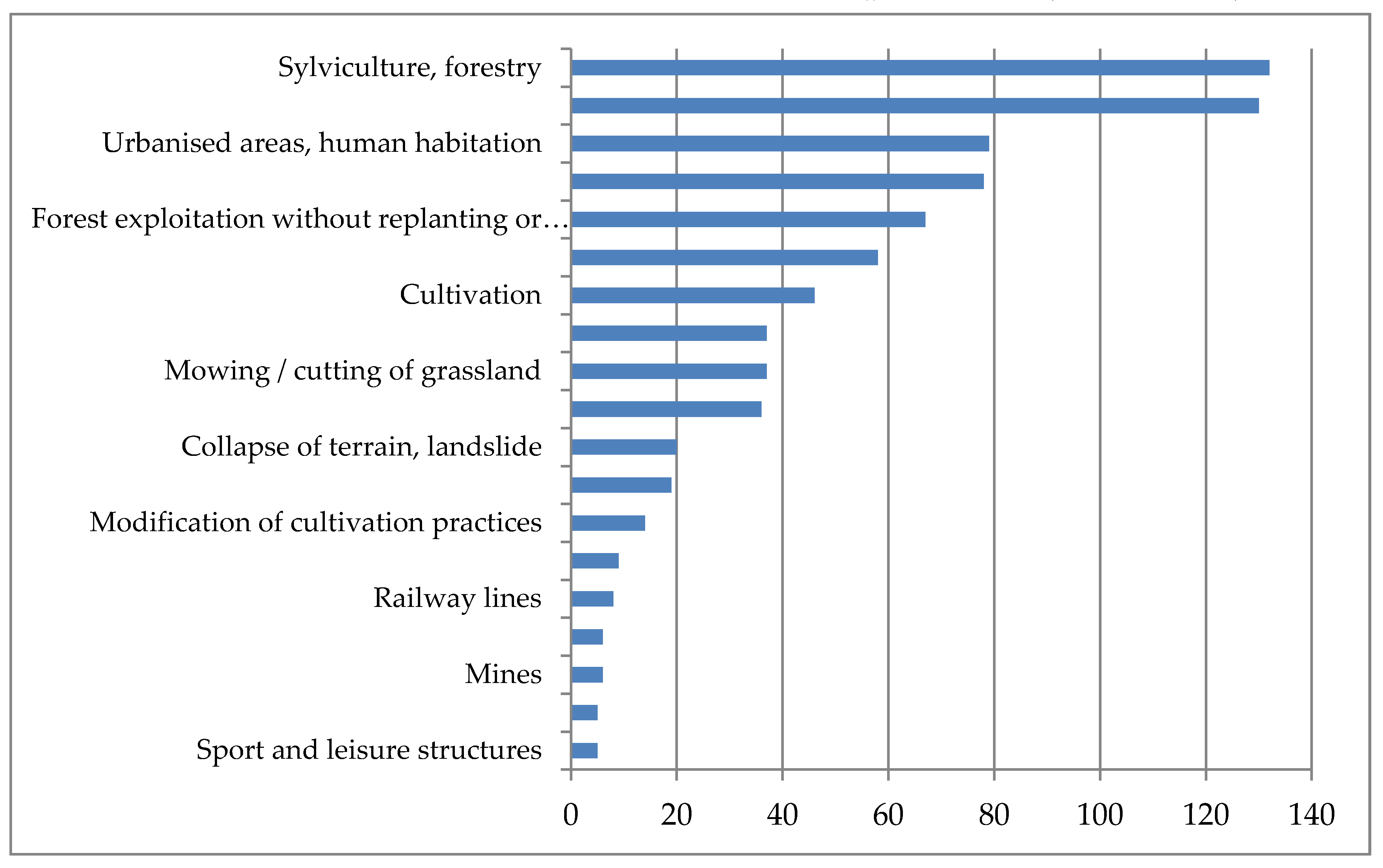
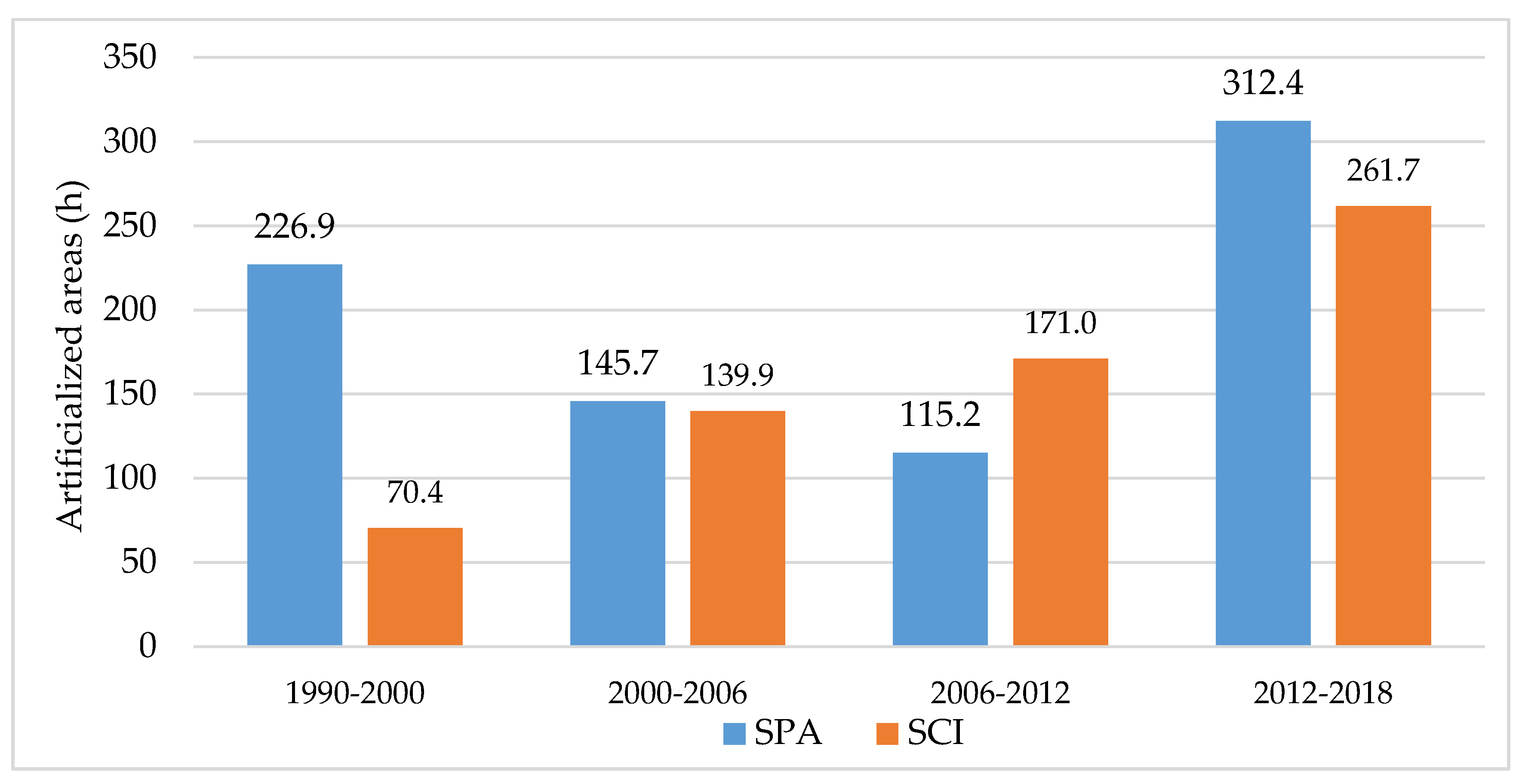
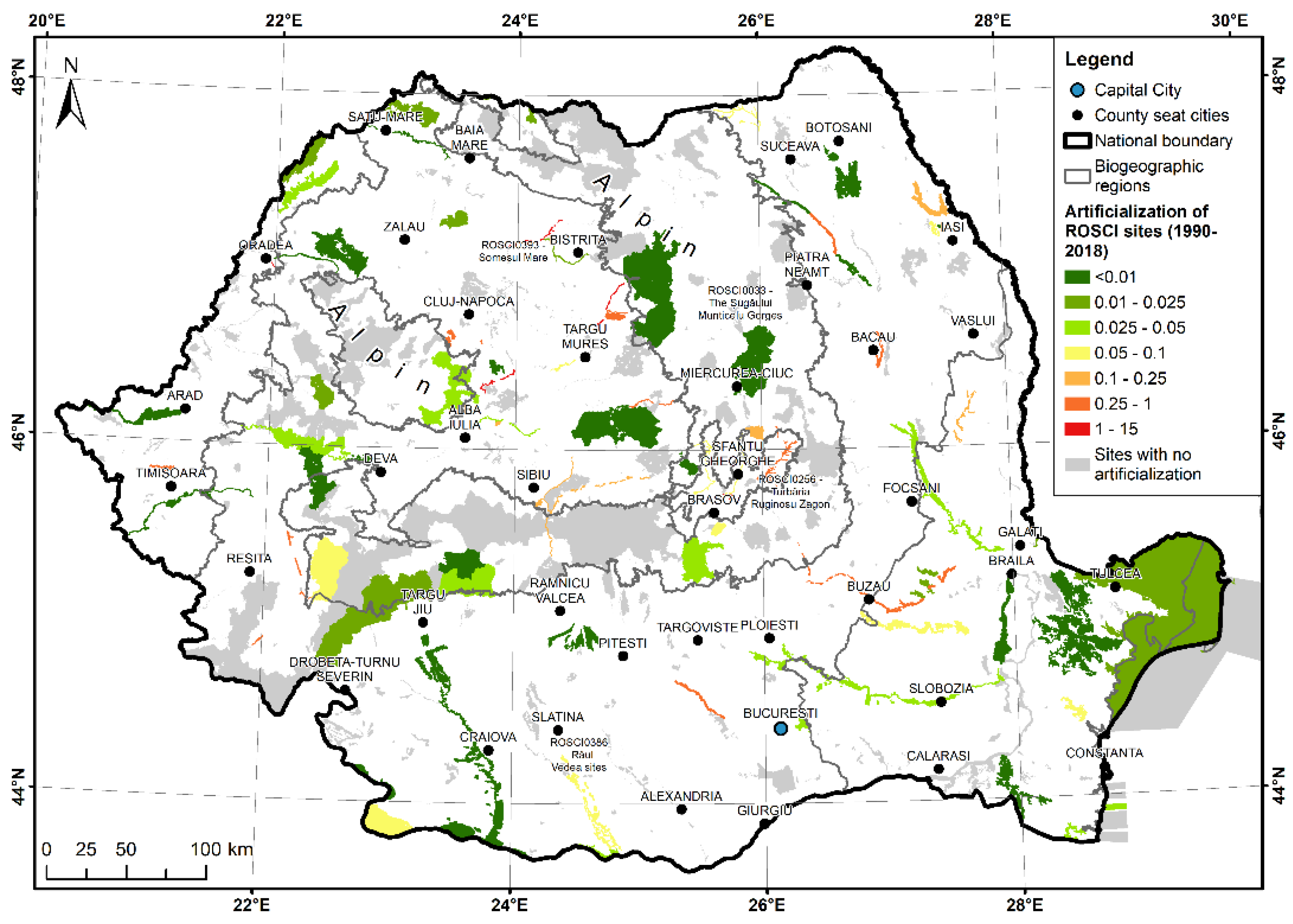

| Class 1. Artificial surfaces | 1.1. Urban fabric | 1.1.1. Continuous urban fabric, 1.1.2. Discontinuous urban fabric |
| 1.2. Industrial, commercial and transport units | 1.2.1. Industrial and commercial units, 1.2.2. Road and rail networks and associated land, 1.2.3. Port areas, 1.2.4. Airports | |
| 1.3. Mine, dump and construction sites | 1.3.1. Mineral extraction sites, 1.3.2. Dump sites, 1.3.3. Construction sites | |
| 1.4. Artificial non-agricultural vegetated areas | 1.4.1. Green urban areas, 1.4.2. Sport and leisure facilities | |
| Class 2. Agricultural areas | 2.1. Arable land | 2.1.1. Non-irrigated arable land, 2.1.2. Permanently irrigated land, 2.1.3. Rice fields |
| 2.2. Permanent crops | 2.2.1. Vineyards, 2.2.2. Fruit trees and berry plantations, 2.2.3. Olive groves | |
| 2.3. Pastures | 2.3.1. Pastures | |
| 2.4. Heterogeneous agricultural areas | 2.4.1. Annual crops associated with permanent crops, 2.4.2. Complex cultivation patterns, 2.4.3. Land principally occupied by agriculture, with significant areas of natural vegetation, 2.4.4. Agro-forestry areas | |
| Class 3. Forests and semi-natural areas | 3.1. Forests | 3.1.1. Broad-leaved forest, 3.1.2. Coniferous forest. 3.1.3. Mixed forest |
| 3.2. Shrub and/or herbaceous vegetation association | 3.2.1. Natural grassland, 3.2.2. Moors and heathland, 3.2.3. Sclerophyllous vegetation, 3.2.4. Transitional woodland shrub | |
| 3.3. Open spaces with little or no vegetation | (3.3.1. Beaches, dunes, and sand plains, 3.3.2. Bare rock, 3.3.3. Sparsely vegetated areas, 3.3.4. Burnt areas, 3.3.5. Glaciers and perpetual snow | |
| Class 4. Wetlands | 4.1. Inland wetlands | 4.1.1. Inland marshes, 4.1.2. Peat bogs |
| 4.2. Coastal wetlands | 4.2.1. Salt marshes, 4.2.2. Salines, 4.2.3. Intertidal flats | |
| Class 5. Water bodies | 5.1. Inland waters | 5.1.1. Water courses, 5.1.2. Water bodies |
| 5.2. Marine waters | 5.2.1. Coastal lagoons, 5.2.2. Estuaries, 5.2.3. Sea and ocean |
| Natura 2000 Site Code Examples | Changed Area 1990–2006 | Changed Area 2006–2012 | Changed Area 2012–2018 | Trend | Class |
|---|---|---|---|---|---|
| ROSCI0001 | 0.00 | 0.00 | 0.00 |  | No change |
| ROSCI0003 | 0.00 | 0.00 | 12.74 |  | Recent change rise |
| ROSCI0004 | 5.14 | 0.00 | 0.77 |  | Drop and rise change |
| ROSCI0008 | 38.75 | 23.13 | 0.00 |  | Continuous change decrease |
| ROSCI0024 | 0.00 | 30.78 | 6.07 |  | Rise and drop change |
| ROSCI0029 | 23.15 | 0.00 | 0.00 |  | Drop and Stop |
| ROSCI0085 | 1994.93 | 2432.88 | 4844.38 |  | Continuous change rise |
| Pressure Code | Description (Threats and Pressures) | CLC Changes (Codes) | |||||
|---|---|---|---|---|---|---|---|
| A | Agriculture | ||||||
| A01 | Cultivation | 311–244 | 324–211 | 324–243 | 411–211 | 411–243 | |
| A02.01 | Intensification of agriculture | 243–242 | 222–242 | 242–211 | 242–222 | 243–211 | 211–242 |
| A02.02 | Crop change | 213–211 | 221–211 | 222–211 | |||
| A02.03 | Grassland removal for arable land | 231–211 | 231–221 | 231–222 | 231–243 | 231–242 | 321–243 |
| 321–211 | |||||||
| A03.03 | Abandonment/lack of mowing | 321–324 | |||||
| A04.01 | Intensive grazing | 321–231 | 242–231 | 243–231 | |||
| A04.02 | Non-intensive grazing | 231–321 | |||||
| A04.03 | Abandonment of pastoral systems, lack of grazing | 231–324 | 321–324 | ||||
| A06 | Annual and perennial non-timber crops | ||||||
| A06.02 | Perennial non-timber crops | 211–221 | 211–222 | 231–221 | 231–222 | ||
| A06.04 | Abandonment of crop production | 211–231 | 211–324 | 221–324 | 213–231 | 221–231 | 222–231 |
| 213–243 | 221–242 | 221–243 | |||||
| A09 | Irrigation | 211–212 | |||||
| B | Forestry | ||||||
| B01 | Forest planting on open ground | 231–311 | 242–311 | 321–311 | 321–312 | 321–313 | |
| B02 | Forest and plantation, management and use | 311–324 | 312–324 | 313–324 | 324–313 | 324–311 | 324–312 |
| B03 | Forest exploitation without replanting or natural regrowth | 311–211 | 311–231 | 311–222 | 311–242 | 311–243 | 324–321 |
| 311–112 | 311–321 | 311–331 | 312–322 | 312–231 | 312–321 | ||
| 313–231 | 313–132 | 313–222 | 313–242 | 313–243 | |||
| 313–321 | |||||||
| C | Mining, extraction of materials and energy production | ||||||
| C01.01 | Sand and gravel extraction | 321–131 | 331–131 | 411–131 | 511–131 | 211–131 | |
| C01.01.01 | Sand and gravel quarries | 321–131 | 331–131 | 411–131 | 511–131 | 211–131 | |
| C01.01.02 | Removal of beach materials | 321–131 | 331–131 | 411–131 | 511–131 | 211–131 | |
| C01.02 | Loam and clay pits | 231–131 | 243–131 | 211–131 | |||
| C01.03 | Peat extraction | 412–131 | |||||
| C01.04 | Mines | 313–131 | 311–131 | 324–131 | |||
| C01.04.01 | Open cast mining | 231–131 | |||||
| D | Transportation and service corridors | ||||||
| D01 | Roads, paths and railroads | 211–122 | 231–122 | 311–122 | |||
| D01.02 | Roads, motorways | 211–122 | 231–122 | 311–122 | |||
| D01.04 | Railway lines, TGV | 231–122 | |||||
| D03 | Shipping lanes, port, and marine construction | 133–123 | |||||
| E | Urbanisation, residential and commercial development | ||||||
| E01.02 | Discontinuous urbanisation | 221–112 | 242–112 | 243–112 | 324–112 | 331–112 | 211-112 |
| 231–112 | 411–112 | 512–112 | |||||
| E02 | Industrial or commercial areas | 133–121 | 211–121 | 231–121 | 242–121 | 321–121 | 243-121 |
| 411–121 | 133–121 | 211–121 | 242–121 | 321–121 | 243-121 | ||
| E02.01 | Factory | 231–121 | |||||
| E06 | Other urbanisation, industrial and similar activities | 211–133 | 221–133 | 231–133 | 242–133 | 243–133 | 331-133 |
| 411–133 | |||||||
| G | Human intrusions and disturbances | ||||||
| G02 | Sport and leisure structures | 411–142 | 211–142 | 231–142 | 243–142 | 311–142 | 321-142 |
| G02.07 | Sports pitch | 411–142 | 211–142 | 231–142 | 243–142 | 311–142 | 321-142 |
| G02.08 | Camping and caravans | 411–142 | 211–142 | 231–142 | 243–142 | 311–142 | 321-142 |
| H | Pollution | Not suitable for CLC | |||||
| I | Invasive, other problematic species and genes | Not suitable for CLC | |||||
| J | Natural System modifications | ||||||
| J02.01 | Landfill, land reclamation and drying out, general | 511–211 | 511–221 | 511–231 | 511–324 | 512–211 | 523-331 |
| 411–211 | |||||||
| J02.06 | Water abstractions from surface waters | 512–234 | 511–411 | ||||
| J02.13 | Abandonment of management of water bodies | 512–411 | 512–243 | 512–231 | |||
| J03.03 | reduction, lack or prevention of erosion | 331–523 | |||||
| K | Natural biotic and abiotic processes (without catastrophes) | Partially suitable for CLC | |||||
| K01.01 | Erosion | 211–331 | 321–331 | 324–331 | |||
| K01.03 | Drying up | 511–243 | 511–311 | 511–321 | 511–331 | ||
| K01.04 | Inundation | 211–411 | 211–511 | 211–512 | 221–512 | 242–512 | 243-511 |
| 231–411 | 231–511 | 231–512 | 243–512 | 311–511 | 311-512 | ||
| 321–511 | 321–512 | 324–511 | 324–512 | 331–411 | 331-511 | ||
| 331–512 | 411–511 | 411–512 | 511–512 | ||||
| L | Geological events, natural catastrophes | Partially suitable for CLC | |||||
| L05 | Collapse of terrain, landslide | 311–331 | 211–331 | 321–331 | 324–331 | ||
| M | Climate change | Not suitable for CLC | |||||
© 2020 by the authors. Licensee MDPI, Basel, Switzerland. This article is an open access article distributed under the terms and conditions of the Creative Commons Attribution (CC BY) license (http://creativecommons.org/licenses/by/4.0/).
Share and Cite
Ursu, A.; Stoleriu, C.C.; Ion, C.; Jitariu, V.; Enea, A. Romanian Natura 2000 Network: Evaluation of the Threats and Pressures through the Corine Land Cover Dataset. Remote Sens. 2020, 12, 2075. https://doi.org/10.3390/rs12132075
Ursu A, Stoleriu CC, Ion C, Jitariu V, Enea A. Romanian Natura 2000 Network: Evaluation of the Threats and Pressures through the Corine Land Cover Dataset. Remote Sensing. 2020; 12(13):2075. https://doi.org/10.3390/rs12132075
Chicago/Turabian StyleUrsu, Adrian, Cristian Constantin Stoleriu, Constantin Ion, Vasile Jitariu, and Andrei Enea. 2020. "Romanian Natura 2000 Network: Evaluation of the Threats and Pressures through the Corine Land Cover Dataset" Remote Sensing 12, no. 13: 2075. https://doi.org/10.3390/rs12132075
APA StyleUrsu, A., Stoleriu, C. C., Ion, C., Jitariu, V., & Enea, A. (2020). Romanian Natura 2000 Network: Evaluation of the Threats and Pressures through the Corine Land Cover Dataset. Remote Sensing, 12(13), 2075. https://doi.org/10.3390/rs12132075





